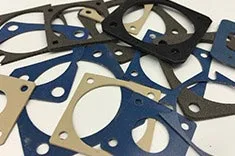EMI Shielding Products
- Custom Gasket Fabrication
- Connector Gaskets
- Bonded O Ring
- Custom Gaskets
- Conduct-O-Knit Knitted Wire Mesh
- Conduct-O-Seal Combo Gasket
- Conduct-O-Elastomer
- Conduct-O-Seal Oriented Wire in Silicone Gasket Material
- Conduct-O-Mesh Tape
- Conduct-O-Foam
- Conduct-O-Bond
- Optical Filters For Electronic Displays
- Shielded Vent Panels
- ESC Board Level Shielding
- 300 Series
RF Shielding and its Critical Role in Modern Electronics
 In our current era of technological innovation, electronic devices are increasingly compact and operate at higher frequencies, making the management of electromagnetic interference (EMI) critically important. RF shielding is an essential technique used to ensure that electronic devices operate effectively without disrupting or being disrupted by external electromagnetic noise, complying with stringent global standards for Electromagnetic Compatibility (EMC).
In our current era of technological innovation, electronic devices are increasingly compact and operate at higher frequencies, making the management of electromagnetic interference (EMI) critically important. RF shielding is an essential technique used to ensure that electronic devices operate effectively without disrupting or being disrupted by external electromagnetic noise, complying with stringent global standards for Electromagnetic Compatibility (EMC).
What is Electromagnetic Interference?
EMI occurs when an electrical circuit is impacted by electromagnetic induction or radiation from an external source. This disturbance can affect the performance of electronic devices, leading to malfunctions or failures. It can be particularly hazardous in systems critical to safety, such as in medical and aviation electronics.
Why is Shielding Necessary?
Shielding encloses electronic components in a conductive barrier, preventing the escape of interfering electromagnetic fields generated by the device and blocking external electromagnetic fields from entering the device. This is fundamental to achieving EMC, which ensures that devices operate without interference in their intended operational environments.
Core Principles of Effective Shielding
The effectiveness of shielding, known as Shielding Effectiveness (SE), is determined by the ability of the barrier to attenuate electromagnetic energy. SE depends on factors such as:
- Conductivity: The ability of the shield material to conduct electricity, which affects its ability to reflect electromagnetic waves.
- Permeability: The ability of the material to support the formation of magnetic fields within itself, relevant for magnetic shielding.
- Thickness: The thickness of the shielding material directly impacts its ability to absorb electromagnetic energy.
Strategies for Implementing Shielding
- Board-Level Shielding (BLS): This involves placing metallic enclosures on the printed circuit board (PCB) to shield specific components or circuit sections from EMI. It is a direct and effective method to contain and control EMI at the source.
- Use of RF Gaskets: These gaskets seal the edges of electronic enclosures and are critical in areas where different sections of an enclosure meet. RF gaskets prevent the leakage of electromagnetic fields through these seams and are chosen based on their impedance properties and environmental resilience.
- Metal Enclosures: Encasing devices or circuits in metal enclosures provides comprehensive shielding. The effectiveness of such enclosures can be enhanced by adding RF gaskets at openings and joints to ensure continuous conductivity.
RF Shielding Technologies/RF Shielding Solutions
RF shielding is not merely a technical requirement but a fundamental aspect of modern electronic design. It ensures devices are reliable and safe in environments filled with electromagnetic disturbances. Understanding and implementing advanced shielding solutions is crucial for technology developers who wish to lead in their fields and meet the rigorous standards of today’s electronic products. Effective shielding practices are paramount for the success of any electronic device in the market.



